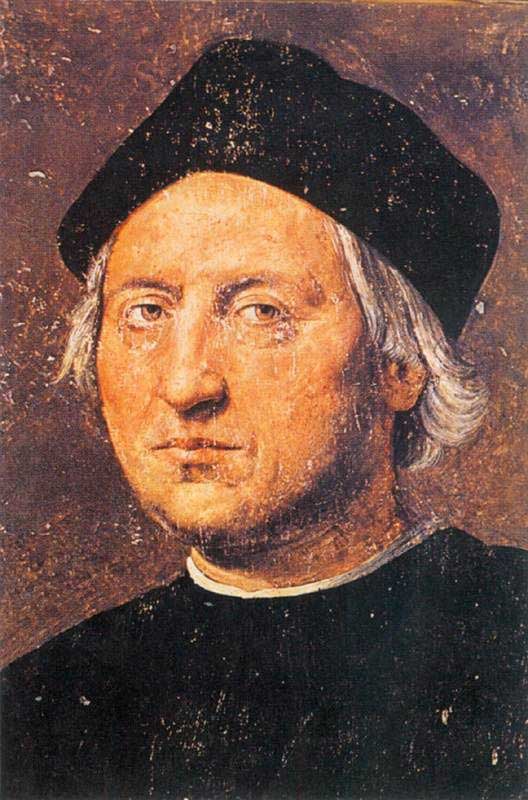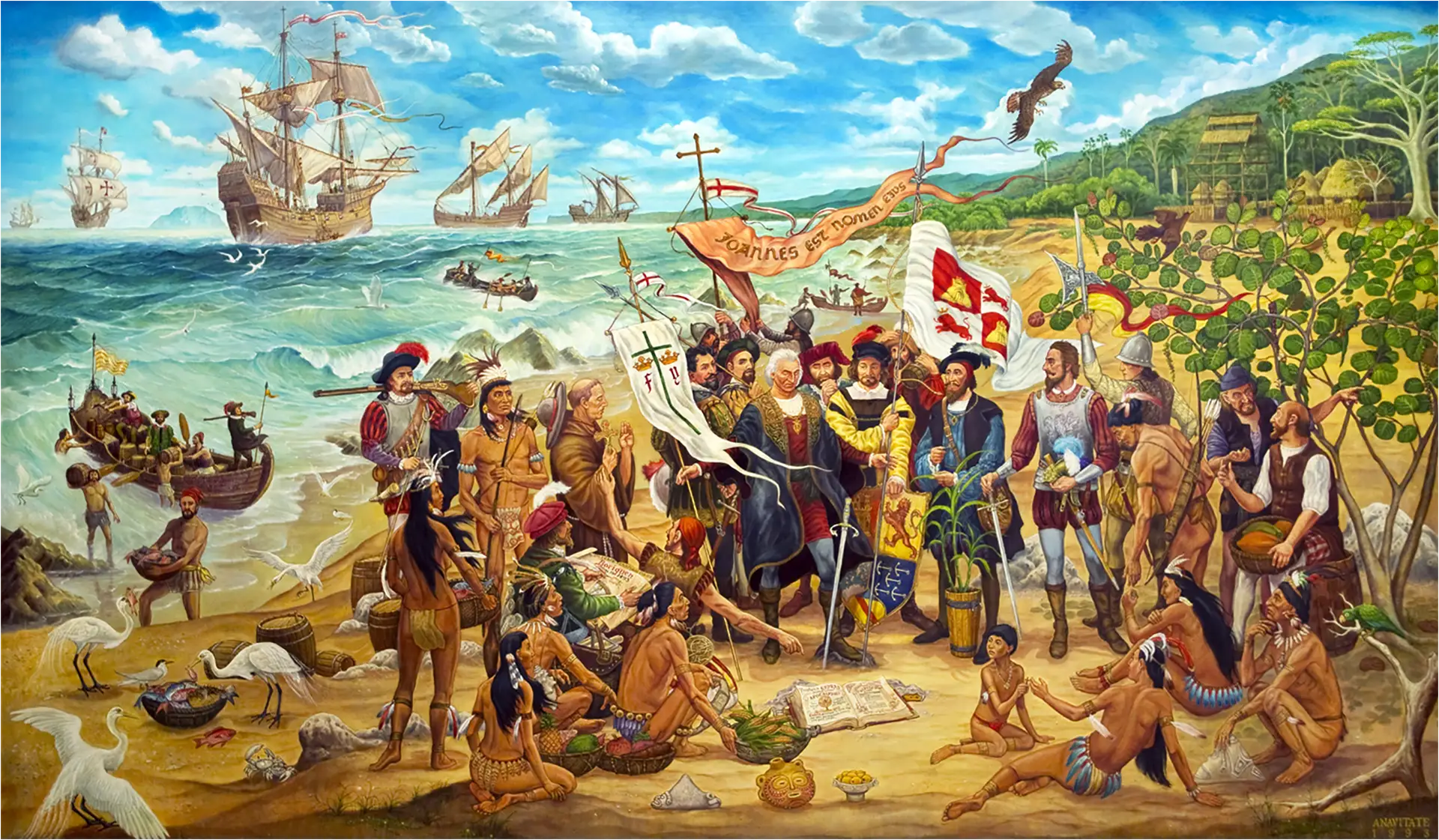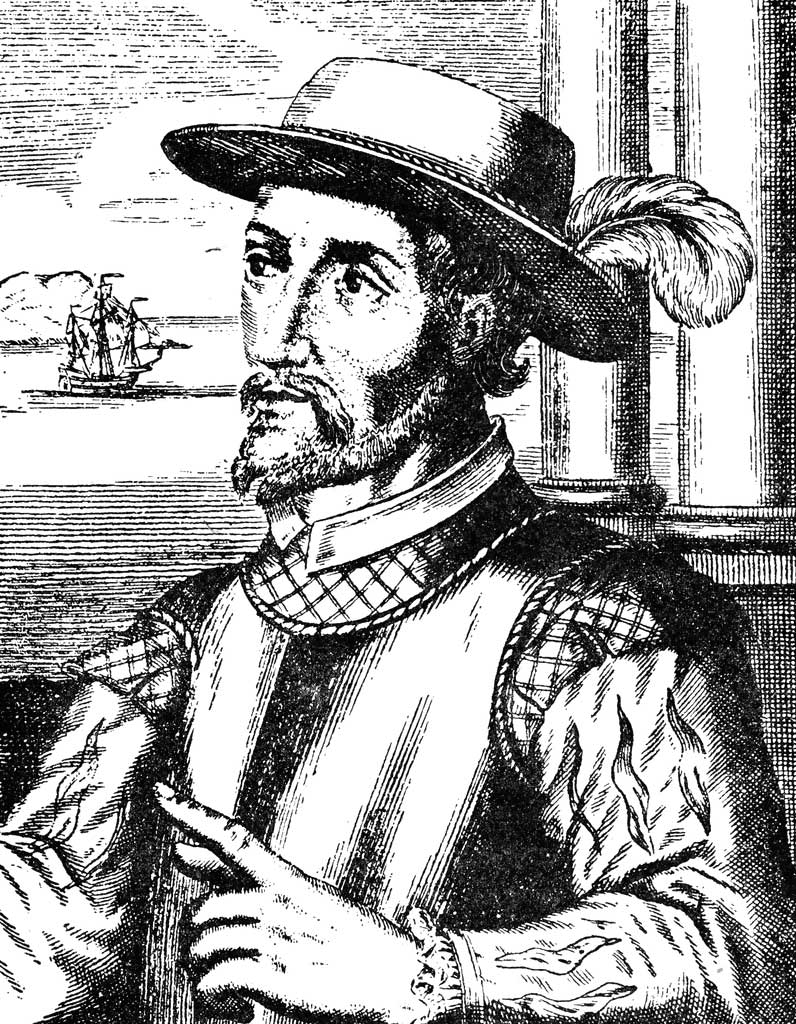Puerto Rico's History
XV Century - 1599XV Century
Taíno ![]() Indians who inhabited the territory, called
the island Boriken or Borinquen which means: "the great land of
the valiant and noble Lord" or "land of the great lords". Today this word -used
in various modifications- is still popularly used to designate the people and
island of Puerto Rico.
The Taíno
Indians, who came from the Orinoco River in present Venezuela, inhabited the major portion of the
island when the Spaniards arrived. The Taíno Indians, lived in small
villages or "bateyes", and were organized in clans, led by a Cacique, or chief. They were a
peaceful people who, with a limited knowledge of agriculture, lived on such
domesticated tropical crops as pineapples, cassava, and sweet potatoes
supplemented by seafood.
Indians who inhabited the territory, called
the island Boriken or Borinquen which means: "the great land of
the valiant and noble Lord" or "land of the great lords". Today this word -used
in various modifications- is still popularly used to designate the people and
island of Puerto Rico.
The Taíno
Indians, who came from the Orinoco River in present Venezuela, inhabited the major portion of the
island when the Spaniards arrived. The Taíno Indians, lived in small
villages or "bateyes", and were organized in clans, led by a Cacique, or chief. They were a
peaceful people who, with a limited knowledge of agriculture, lived on such
domesticated tropical crops as pineapples, cassava, and sweet potatoes
supplemented by seafood.
1492

On April 17, Ferdinand and Isabella of Spain signed the agreement to finance and set the terms of Columbus's voyage to the Indies. The document is known as the Capitulations of Santa Fe. The agreement established that Columbus would become the viceroy and governor of all discovered land and rights to 10% of all assets brought to Spain, among other terms.
On August 3, the fleet of three ships --the Niña, the Pinta, and the Santa María-- set forth from Palos, Spain. The first sighting of land came at dawn on October 12. They landed at San Salvador, in the Bahamas. Thinking he had reached the East Indies, Columbus referred to the native inhabitants of the island as "Indians," a term that was ultimately applied to all indigenous peoples of the New World.
1493
After the success of Columbus's first voyage, he had little trouble convincing Ferdinand and Isabela of Spain, to follow up immediately with a second voyage. Unlike the exploratory first voyage, the second voyage was a massive colonization effort. On September 25, Christopher Columbus set sail from Cádiz, Spain with 17 ships and almost 1,500 men. The second voyage brought European livestock (horses, sheep, and cattle) to America for the first time.
On November 19, Christopher Columbus discovered the island in his second voyage to the New World. He found the island populated by as many as 50,000 Taíno or Arawak Indians. The Taíno Indians who greeted Columbus made a big mistake when they showed him gold nuggets in the river and told him to take all he wanted. Originally the newcomers called the island San Juan Bautista, for St. John the Baptist and the town was named Puerto Rico ("rich port") for its abundance of natural resources, specially gold and its excellent location. It was not until later that the two names were switched. Thanks in part to the enthusiasm of ambitious Juan Ponce de León, a lieutenant to Columbus, the city of Puerto Rico, it quickly became Spain's most important military outpost in the Caribbean.

By Agustin Anavitate (1993)
1501
The Spanish Crown permitted export of slaves to America.
1503
Governor Nicolás de Ovando opposes the importing of slaves.
First slaves arrive in Hispañola.
1505
On March 25, Vicente Yañez Pinzón Captain was appointed "corregidor" of the island San Juan Bautista and governor of the fort that he was to construct therein.
1506
On May 20, Christopher Columbus died in Valladolid, Spain.
1508
Spanish colonization begins. King Ferdinand II of Aragon assigned Ponce de León to lead an official expedition to the island.
On January 14, first school in Puerto Rico was established in Caparra.
On June 15, 1508, Nicolas de Ovando, the viceroy of Espanola (Hispaniola), granted Ponce de Leon the privilege to explore and subjugate the island of San Juan Bautista.
On August 8, Juan Ponce de León founded the Caparra Village near the bay on the north coast, not far from the modern city of San Juan. It became the first European settlement in Puerto Rico.
Puerto Rican archeologist, Don Ricardo Alegria estimated that the island had some 30,000 inhabitants.
1509
The Spanish authorities refused to grant to Diego Columbus (Christopher's son) privileges to all discovered land, as a results, the Crown officially appointed Juan Ponce de León governor of the island.
The first repartimiento in Puerto Rico was established, this system consisted of distributing among officials and colonists fixed numbers of Indians for wage-free and forced labor.
The Spanish Crown instituted the encomienda after several priests protested against the treatment to Indians under the repartimiento system. The terms of the new agreement specified that Spaniards were obliged to pay the Indians for their labor and to teach them the Christian religion, but they soon reduced the Indians to a condition of abject slavery, claiming that the Indians were inferior and subhuman; therefore Indians were forced to work from dawn until dusk, under threat of corporal punishment and death.
In his book "La colonización de Puuerto Rico", historian Salvador Brau states that the repartimiento recorded 60,000 Indians, six years later in 1515, only 14,636 remained.
Juan Garrido is the first African identified in Puerto Rico. A free man, he arrived with the Ponce De León expedition. Garrido later participates in the colonization of Florida and serves with Spanish explorer Hernan Cortex in the conquest of Mexico.
1510
Differences between Spaniards and Taíno Indians began and conflicts soon arose as the settlers began subjugating the Taino.
The Cacique Urayoán ordered his warriors to drown Diego Salcedo to determine whether or not the Spaniards were immortal, as they believed that Spanish colonizers had divine powers. It is told that after they drowned Diego, they watched him for several days until they were sure that he was dead.
1511
The Taíno Indians' after learning through the drowning of Diego Salcedo, that the Spanish were mortal, revolted against Spaniards with no success. Ponce de León orders 6,000 shot on the spot in the town square; survivors flee to mountains or left the island.
Diego Columbus won rights to all land discovered by his father after presenting his case to the courts in Madrid. King Ferdinand ordered Ponce de Leon to be replaced as governor by Diego Columbus. Ponce de León not wishing to serve Diego, obtained title to explore the Upper Bahamas and areas to the North.
On August 8, Pope Julius II created two dioceses in Puerto Rico, the bishop of which were all suffragans of the archbishopric of Seville. The Canon of Salamanca, Alonso Manso, was appointed bishop of the Puerto Rican diocese and took possession in 1513 - the first bishop to arrive in America.
On November 11, the Spanish Crown granted a Coat of Arms to the Island of Puerto Rico.
1512
On September 26, the first school of advanced studies was established by Bishop Alonso Manso.
On December 27, the Burgos Law is issued, by Ferdinand II, the Catholic, of Aragón, regulated relations between Spaniards and the conquered Indians, particularly to ensure the spiritual and material welfare of the latter, who were often severely treated.
After the Taino upprising in 1511, a second settlement in San Germán was founded.
1513
On January 27, with the decline of Taino slaves, African slaves were introduced into the island.
On July 28th, the Complementary Declaration was established. Granting natives who were clothed, Christian, and capable could live their own lives.
On March, Ponce de León sailed into the Bahamas headed toward Florida.
1514
The Spanish Crown granted permission to Spaniards to marry native Taíno Indians.
Hernando de Peralta received permission to obtain 2 white slaves, possibly Arab or Arab Descent.
Caribe Indians attacked settlements along the banks of the Daguao and Macao rivers that had been founded by Diego Columbus.
Mona Island is officially annexed to Puerto Rico.
1515
On July, a hurricane strikes the island, killing many Indians.
1517
King Carlos V authorized the importation of 4,000 slaves to the Caribbean.
1519
Government Center is moved from Villa de Caparra to the isle of San Juan.
Puerto Rico became the general headquarters of the Inquisition, after Pope Leo X declared the island the first ecclesiastical headquarters in the New World.
1520
On July 12, King Charles I of Spain issued a royal decree collectively emancipating the remaining Taíno population. The order came into place due to the large number of Taino deaths attributed to the continuing bondage systems. A population of 60,000 was reduced to 4,000 in seven years.
1521

Caribe Indians attacked the south coast.
The city and the Island exchanged names, and the City of San Juan Bautista de Puerto Rico became the official capital.
Casa Blanca (White House) was built. The house was owned by Ponce de León's family until the late 18th century.
The ever arriving Spaniards settlers, many of them gold-seekers, brought no women on their ships. To populate the country, the Spaniard took Indian women. With the arrival of African slaves, other elements were added. This historic intermingling has resulted in a contemporary Puerto Rico without racial problems.
Juan Ponce de León organized an expedition, setting out for Florida, where he suffered serious injuries. He took refuge on La Habana, Cuba, where he died.
1522
On January 24, San Jose Church is founded, it is the oldest church still in use in America.
1523
The first sugar cane processing plant is built.
The Convento de Santo Domingo (Dominican Friars Community) was built. The convent organized the first library in the island.
1524
The first hospital was built, called Concepción, by Bishop Alonso Manso.
1528
On their attempt to capture the Island the French attacked many settlements. On October 11, the French sacked and burned San Germán. All the other first settlements-Guánica, Sotomayor, Daguao and Loíza-had disappeared. Only the capital remained.
1530
Sugar became the most important agricultural product.
Governor Francisco Manuel de Landó conducted the first census. The Taino population had almost vanished. Lando's census reports only 1148 Tainos remaining in the island.
On July 26, August 23, and August 31, within 6 weeks three storms strikes the island.
1532
The construction of Santa Catalina Palace, the governors house, began. Later the name was changed to La Fortaleza.
1533
On July 26, a hurricane strikes the island.
A month later, on August 23, another hurricane strikes the island.
1537
On July, a hurricane strikes the island. Few weeks later, on August another hurricane strikes the island. Many slaves died.
1539
Concerned about potential threats from European enemies and recognizing the strategic importance of Puerto Rico, Spain began constructing massive defenses around San Juan. The construction of San Felipe del Morro Castle began. The fort featured 18-foot-thick walls; San Cristóbal and San Geronimo Forts also garrisoned troops, were built with the financial subsidy from the Mexican mines. Next the Spaniards constructed a wall, parts of which still survive, around the entire city.
1542
The coconut tree was introduced to the island. The coconut is indigenous to the Indo-Malaysian region. It spread by sea currents with the average maximum distance of 3,000 miles, on which the coconut will remain afloat and still remain viable. Considering these limitations there were no or little chance of a coconut seed reach the New World. Most authorities agree that the coconut was introduced to the New World by Portuguese and Spanish traders.
1544
The second hospital was built, called San Ildefonso.
Charles V, Holy Roman Emperor and King of Spain decreed that the natives be as free. In reality though, the declaration of equality did not end the colonial social class system.
1559
Juan Ponce de León remains were brought to San Juan.
1570
The gold mines were declared depleted.
1587
Engineers Juan de Tejada and Juan Bautista Antonelli lay out the main design for El Morro still seen today.
1595
On November 22, Sir Francis Drake, hero of the battle of the Spanish Armada, with 26 vessels, in the company of Sir John Hawkins, tried fruitlessly to conquer the island and set San Juan city on fire (battlemap).
1598
On June 15, the British Navy led by George Clifford, 3rd Earl of Cumberland, landing in Santurce, conquered the island and held it for several months, it is forced to abandon his conquest owing to an outbreak of plague among his troops (battlemap).
Ginger replaces sugar as Puerto Rico's main cash crop.
1599
Spain sent 400 soldiers, 46 cannon and a new governor, Alonso de Mercado, to rebuild San Juan.
Other Resources
- History of Puerto Rico: A Panorama of Its People
- The Four Voyages of Christopher Columbus
- The Indigenous People of the Caribbean
- In Defense of the Indians : The Defense of the Most Reverend Lord, Don Fray Bartolome de las Casas, of the Order of Preachers, Late Bishop of Chiapas
- Juan Ponce De León and the Spanish Discovery of Puerto Rico and Florida
- Puerto Rico : The Trials of the Oldest Colony in the World
- Puerto Rico : A Political and Cultural History
- The Tainos : Rise & Decline of the People Who Greeted Columbus
- Puerto Rico Facts for Kids
- Columbus Day? True Legacy: Cruelty and Slavery
- The History of Puerto Rico From the Spanish Discovery to the American Occupation



